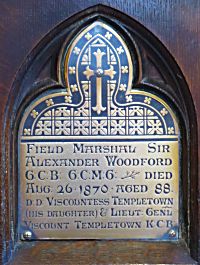The plaque is on the back of one of the choristers stalls in the chancel.
South side, back row, fifth from the west end.

ALEXANDER WOODFORD
G.C.B., G.C.M.G. DIED
AUG 26 1870 AGE 88.
DD: VISCOUNTESS TEMPLETOWN
(HIS DAUGHTER) & LIEUT GENL
VISCOUNT TEMPLETOWN K.C.B.
Further Information
Field Marshall Woodford, son of Colonel John Woodford formerly of the Grenadier Guards, and of Susan Gordon, eldest daughter of Cosmo George 3rd Duke of Gordon, and widow of John 9th Earl of Westmoreland, was born in 1782, and entered the army in 1794, as Cornet in the 14th Light Dragoons. In 1795 was appointed a Lieutenant, and in 1799, joined the 9th Foot, from Winchester School, and was present in the campaign in North Holland in 1799. Was severely wounded in the action of the 19th September that year at St Morel, and was gazetted killed.
In 1800 was exchanged and returned to England, and promoted by purchase to a Captain-Lieutenancy in the 9th Foot in the same year. Exchanged into the Coldstream Guards as Lieutenant and Captain in 1800. Appointed to the staff as Aide-de-Camp to Major General The Honourable James Forbes, afterwards Lord Forbes, and was stationed at Ashford and Dover forming part of the army assembled on the coast to repel the threatened invasion of 1803.
In 1807, Sir Alexander rejoined the Coldstream for the Expedition to the Baltic, and was present at the capture of Copenhagen. In 1808 he resumed the staff appointment as Aide-de-Camp to Lord Forbes and served with him in Sicily in 1808, 1809 and 1810. In that year he was promoted by purchase to be Captain and Lieutenant-Colonel Coldstream Guards, and joined the second batallion the same year. In 1811, he joined the 1st Batallion serving under the Duke of Wellington in Portugal, and was present at the siege and capture of Cuidad Rodrigo, and with the corps covering the siege of Badjoz; he commanded the light companies of the Guards at the battle of Salamanca, in defence of the Arapiles, was present at the capture of Madrid and the siege of Burgos. Commanded the rearguard of the army in the retreat from Burgos.
In 1813 succeeded to the command of the 1st Battalion Coldstream Guards, and was present at the battle of Vittoria, and during the operations before San Sebastian, and in the Pyrenees. Was present at the passage of the Bidassoa, and entry into France, and at the crossing of the Nive and Nivelle, and at the affair before Biarritz in December 1813.
In 1814 embarked in the Gironde for England and was promoted to 2nd Major Coldstream Guards, having been previously appointed Aide-de-Camp to the Prince Regent. In 1815 took command of the 2nd Battalion Coldstream Guards at Brussels and was present at the action at Quartre Bras, 16th June, and at the battle of Waterloo. Was engaged as Senior Officer in the defence of Hougomont by the Duke of Wellington's special order, from midday until night. Entered France a second time at the head of the Coldstream, at Malplaquet, and was present at the capture of Paris. Served with the army of occupation for three years at Cambray and embarked for England from Calais in 1818.
In 1820, was promoted to be Lieutenant-Colonel Coldstream Guards. In 1825, was made Major-General, and appointed Lieut-Governor of Malta in that year, and as Major-General on the staff in the Ionian Islands in 1827 and second in command, Acting Lord High Commissioner in 1832. Was appointed Lieut Governor of Gibraltar in 1835 and succeeded Lord Chatham as Governor in 1836 and remained in command until 1842. Appointed Colonel of the 40th Regiment and was President of the Clothing Board for several years. Was President of the Crimean Enquiry. Was appointed Lieut-Governor of Chelsea in 1856 and Governor in 1868. Appointed Colonel of the Scots Fusilier Guards in 1863 and Field Marshall in the army in 1868.
He received the Peninsular and Waterloo medals, the gold medal for Salamanca, Vittoria and the Nive, as well as the cross of Maria Theresa, and St George of Russia, and was Knight Grand Cross of the Military order of the Bath, and of St Michael and St George.
[From the 1873 Guide to the Church]
